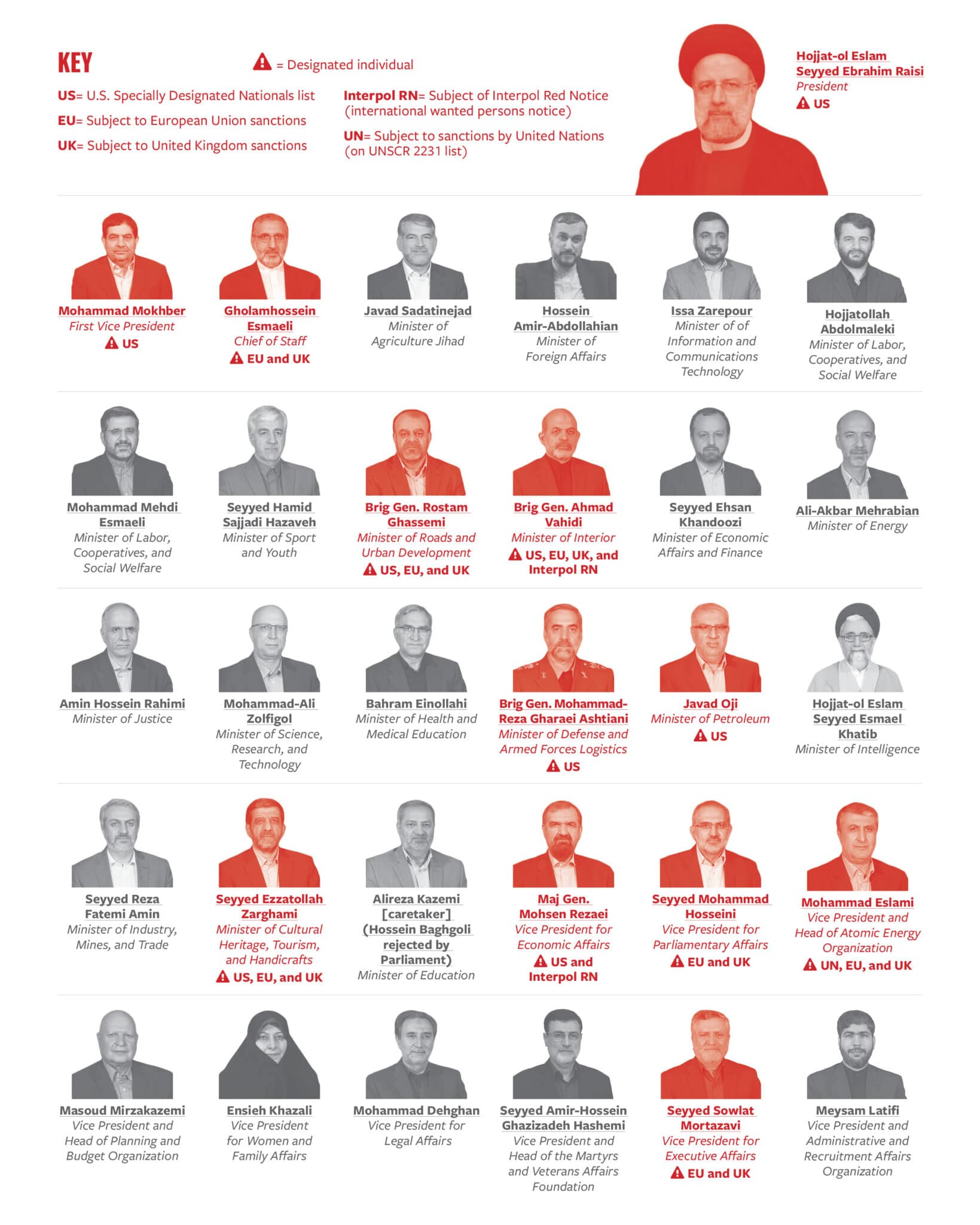September 30, 2021 | Visual
The Sanctioned Cabinet of Ebrahim Raisi
September 30, 2021 | Visual
The Sanctioned Cabinet of Ebrahim Raisi
The Cabinet1 of Iran’s new president, Ebrahim Raisi, represents the culmination of a decades-long political project by Supreme Leader Ali Khamenei to promote ultra-hardline elites to key leadership positions.2 Drawn from an increasingly narrow bench, Raisi’s appointees include several persons who served under former President Mahmoud Ahmadinejad (2005–2013),3 who also harbored immense hostility to the West and stacked his Cabinet with veterans of Iran’s security forces.4
Reflecting this new constellation of power, Raisi’s Cabinet boasts 12 sanctioned individuals, more than any other in the history of the Islamic Republic. These persons are subject to overlapping international penalties imposed by the United States, European Union, United Kingdom, and United Nations due to their role in Khamenei’s networks, support for Iran’s nuclear program, ties to terrorist groups, and human rights abuses. These 12 also hold some of the most important portfolios, including the ministries of defense, interior, and petroleum as well as two vice presidencies.
The Cabinet members under sanctions include eight persons on the U.S. Specially Designated Nationals and Blocked Persons (SDN) List,5 seven persons subject to UK sanctions,6 seven persons subject to EU sanctions,7 and one person on a UN sanctions list.8 The EU and UK lists mirror one another, and both entities will delist the same three persons come October 2023, pursuant to the implementation timeline of the 2015 nuclear deal with Iran, formally known as the Joint Comprehensive Plan of Action (JCPOA).9 Similarly, UN sanctions will terminate in October 2023 pursuant to the same JCPOA implementation timeline.10 The other four EU and UK designations against members of Raisi’s Cabinet will remain, as they were issued under human rights-related authorities and are separate from each entity’s JCPOA commitments. Three of those four individuals have yet to be sanctioned by the U.S. Treasury Department.11
While Raisi is by now known for serving on a “death commission” in 1988 that led to the execution of several thousand political prisoners, he is subject to U.S. sanctions for having been elevated by Khamenei to a state position.12 Several other Cabinet members have been designated under this broad and unique U.S. sanctions authority, which exposes and penalizes the supreme leader’s network of appointees.13 They include First Vice President Mohammad Mokhber,14 who previously led a multibillion-dollar holding company owned by the supreme leader, known by its acronym, EIKO,15 as well as three others.16
Some cabinet members are subject to multiple sanctions authorities given their myriad crimes. A prime example is Rostam Ghassemi, a brigadier general in Iran’s Islamic Revolutionary Guard Corps (IRGC), an ideological force parallel to the Artesh (national military). The U.S. Treasury Department, using counterproliferation authorities, sanctioned Ghassemi in 2010 for supporting the IRGC’s “engineering arm.” Treasury designated him again in 2019, this time using counterterrorism authorities, for working for the IRGC’s Quds Force and its then-chief, Major General Qassem Soleimani, to illicitly export Iranian oil.17 Ghassemi is also subject to EU and UK nuclear-related sanctions but is slated to be delisted by October 2023 pursuant to the JCPOA.18
Furthermore, two members of Raisi’s Cabinet are subject to Interpol Red Notices — requests to locate wanted criminals — for their involvement in the 1994 terror attack against the AMIA Jewish Community Center in Buenos Aires, Argentina, which killed 85 people.19 Both are affiliated with the IRGC.20 Although Raisi’s Cabinet, like his predecessor’s, has an Artesh officer at the helm of the defense ministry,21 there at least three individuals in Raisi’s Cabinet who attained the rank of general in the IRGC. Multiple other Cabinet members have worked with or retain ties to the IRGC. The United States has designated the IRGC as a Foreign Terrorist Organization,22 but Iranian official sources allege that Washington will drop this penalty if nuclear negotiations result in a new agreement.23
During confirmation proceedings in the Iranian Majlis (parliament), Speaker Mohammad Bagher Ghalibaf confirmed an open secret: Khamenei personally approved key appointments to the Cabinet for positions related to national security, including but not limited to the minister of intelligence.24 Accordingly, the Majlis approved all but one of Raisi’s Cabinet nominees.25
Per Iranian law, the minister of intelligence must be a Mujtahid (a religious scholar),26 which remains the case for Raisi’s Cabinet. Ahmadinejad unsuccessfully contested the supreme leader’s choice for minister of intelligence in 2011, resulting in a political crisis late in his second presidential term.27
Khamenei’s willingness to have a Cabinet in which almost 40 percent of its members are subject to sanctions reflects his comfort with escalating tensions with the outside world and his confidence in not needing to feign moderation to garner relief from sanctions.

Infographic by Daniel Ackerman/FDD